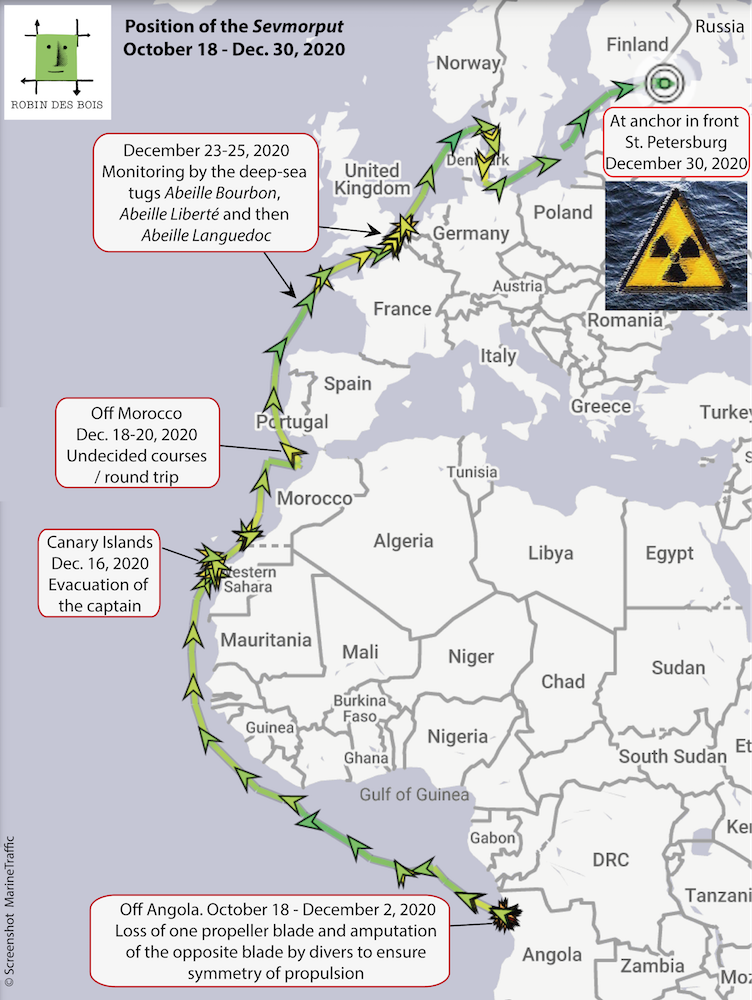Press release n°9 – 11:20 am
The atomic container ship Sevmorput anchored at 10:20 French time in the Bay of Neva in front of St. Petersburg with her 2 cut down blades propeller, 97 crew members and technicians and without her captain. She had left St. Petersburg for Antarctica on October 5, 2020 with a new 4-blades propeller and 5000 tons of general cargo intended for the reconstruction of the Vostok scientific station. In September, she had unloaded in St. Petersburg 5000 tons of sea products from Kamchatka via Murmansk. The prestigious mission of the Sevmorput was to achieve a world premiere, the crossing from the North Pole to the South Pole by a nuclear-powered cargo ship.
Eight press releases from Robin des Bois have already retraced the damage and ups and downs of the Russian atomic container ship (1).
The truth has not yet been fully disclosed. The causes and all the consequences of the initial loss of a blade off Angola are not known and the episode of the health evacuation of the captain off the Canary Islands keeps its share of mystery especially since by a very quick recovery, he was 2 days later in Moscow.
France as a precaution was escorting the Sevmorput in most of the Atlantic waters under its jurisdiction and the 3 deep-sea tugs chartered by the French Navy fulfilled their mission of sea-Samaritan despite difficult weather conditions and while remaining available to respond to other alerts.
Most other European Union countries were satisfied with the assertions of the Russian shipowner and the Sevmorput command that there were no problems with the nuclear reactor. They allowed the damaged Sevmorput to operate unescorted in their Exclusive Economic Zones and territorial waters amidst heavy traffic of oil tankers, chemical tankers and other commercial vessels.
The speed of the heavy laden Sevmorput during her perilous return to St. Petersburg averaged 11 knots (20.4 km/h) with notable slowdowns off Brest, Dunkirk and Rotterdam.
The Marpol Convention for the Prevention of Marine Pollution from Ships is very prescriptive with respect to discharges of oil and sulphur but has never set threshold for radioactive discharges from nuclear-powered merchant ships in usual or damaged operations. The IAEA (International Atomic Energy Agency) and the OSPAR Convention for the Protection of the North-East Atlantic observe the same discretion in this regard. There is no international instrument in force or even in draft form on the designation of place of refuge for nuclear-powered ships or submarines in case of imperative need. While Russia has just put into operation a floating nuclear power plant in the Arctic and other countries such as France are officially or on the sly promoting naval nuclear propulsion for military or civil use, these legal and technical gaps must be filled as soon as possible.
Will the Sevmorput sail again next year to the Antarctic or will she finally sail to the scrapyard? To be continued.
Previous Robin des Bois’s publications on the Sevmorput :
Sevmorput – update, 24 December 2020 – press release n°8 [2]
New position of the Sevmorput, 23 December 2020 – press release n°7 [3]
SAVEmorput, 21 December 2020 – press release n°6 [4]
Technical and health problems on board the Sevmorput, 17 December 2020 – press release n°5 [5]
A disabled atomic ship is heading towards Europe, 14 December 2020 – press release n°4 [6]
Last minute. Sevmorput in breakdown off the coast of Africa, 25 November 2020 – press release n°3 [7]
Sevmorput in breakdown off the coast of Africa, 19 November 2020 – 15h30 – press release n°2 [8]
An atomic merchant ship is zigzagging towards Antarctica, 10 November 2020 [9]
2013- ” Shipbreaking “, Bulletin of information and analysis on end-of-life ships, n°31, pdf 90 pages, 6.54 Mo, cf. page 84. [10]
2014- ” Shipbreaking “, Bulletin of information and analysis on end-of-life ships, n°34, pdf 56 pages, 6.4 Mo, cf. page 12. [11]
